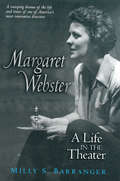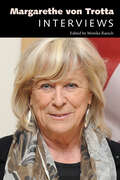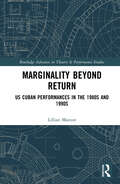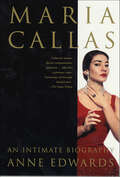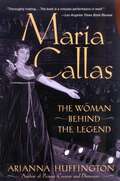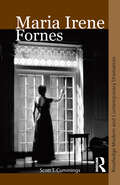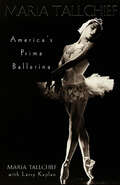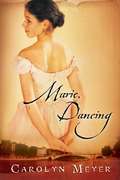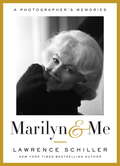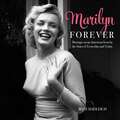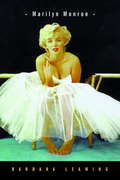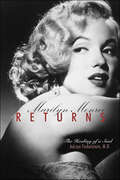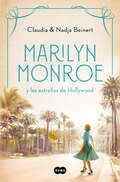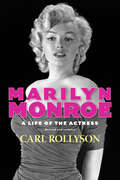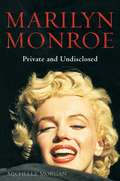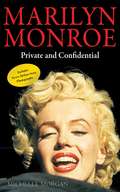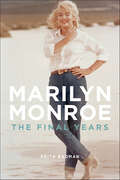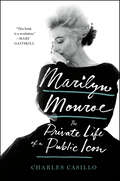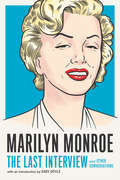- Table View
- List View
Margaret Webster: A Life in the Theater
by Milly S. BarrangerMargaret Webster: A Life in the Theater is an engrossing backstage account of the life of pioneering director Margaret Webster (1905-72). This is the first book-length biography of Webster, a groundbreaking stage and opera director whose career challenged not only stage tradition but also mainstream attitudes toward professional women. Often credited with first having brought Shakespeare to Broadway, and renowned for her bold casting of an African American (Paul Robeson) in the role of Othello, Webster was a creative force in modern American and British theater. Her story reveals the independent-minded artist undeterred by stage tradition and unmindful of rules about a woman's place in the professional theater. In addition to providing fascinating glimpses into Webster's personal and family life, Margaret Webster: A Life in the Theater also offers a who's-who list of the biggest names in New York and London theater of the time, as well as Hollywood: John Gielgud, Noël Coward, George Bernard Shaw, Uta Hagen, Sybil Thorndike, Eva LeGallienne, and John Barrymore, among others, all of whom crossed paths with Webster. Capping Webster's amazing story is her investigation by Senator Joseph McCarthy and HUAC, which left her unable to work for a year, and from which she never fully recovered.
Margarethe von Trotta: Interviews (Conversations with Filmmakers Series)
by Monika RaeschMargarethe von Trotta (b. 1942) entered the film industry in the only way she could in the 1960s—as an actress. Throughout her career, von Trotta added thirty-two acting credits to her name; however, these credits came to a halt in 1975. Her ambition had always been to be a movie director. Though she viewed acting as a detour, it allowed her to be in the right place at the right time, and through her line of work she met such important directors as Rainer Werner Fassbinder and Volker Schlöndorff. The latter would eventually provide her with the opportunity to codirect her first film, Die Verlohrene Ehre der Katharina Blum (The Lost Honor of Katharina Blum) in 1975. The debut's success ensured von Trotta's future in the film industry and launched her accomplished film directing career. In Margarethe von Trotta: Interviews, volume editor Monika Raesch furnishes twenty illuminating interviews with the auteur. Spanning three decades, from the mid-1980s until today, the interviews reveal not only von Trotta's life in the film industry, but also evolving roles of and opportunities provided to women over that time period. This collection of interviews presents the different dimensions of von Trotta through the lenses of film critics, scholars, and journalists. The volume offers essential reading for anyone seeking a better understanding of an iconic female movie director at a time when this possibility for women just emerged.
Marginality Beyond Return: US Cuban Performances in the 1980s and 1990s (Routledge Advances in Theatre & Performance Studies)
by Lillian ManzorThis study is an exploration of US Cuban theatrical performances written and staged primarily between 1980 and 2000. Lillian Manzor analyzes early plays by Magali Alabau, Jorge Ignacio Cortiñas, María Irene Fornés, Eduardo Machado, Manuel Martín Jr., and Carmelita Tropicana as well as these playwrights’ participation in three foundational Latine theater projects --INTAR’s Hispanic Playwrights-in-Residence Laboratory in New York (1980-1991), Hispanic Playwrights Project at South Coast Repertory Theater in Costa Mesa, CA (1986-2004), and The Latino Theater Initiative at Center Theater Group's Mark Taper Forum in Los Angeles (1992-2005). She also studies theatrical projects of reconciliation among Cubans on and off the island in the early 2000s. Demonstrating the foundational nature of these artists and projects, the book argues that US Cuban theater problematizes both the exile and Cuban-American paradigms. By investigating US Cuban theater, the author theorizes via performance, ways in which we can intervene in and reformulate political and representational positionings within the context of hybrid cultural identities. This book will of great interest to students and scholars in Performance Studies, Transnational Latine Studies, Race and Gender studies.
Mari Bariethi-32 Bari Bandh Karta
by Suresh Dalalશરીરમાં જે સ્થાન આંખનું છે એ સ્થાન ઘરમાં બારીનું છે. કહેવું હોય તો એમ કહેવાય કે બારી એ ઘરની આંખ છે. આપણે તો સલામતીથી જીવવામાં માનનારા માનવીઓ; એટલે તો ઘરની ચાર દીવાલો ચણી લીધી. પણ ચાર દીવાલમાં ગૂંગળાઈ રહેવું કેમ પોસાય? આપણે એથી બારીઓ મૂકી. પ્રતીક્ષાના પર્યાય જેવા ઝરૂખાઓ સજાવ્યા, ગૌરવ આપે એવા ગવાક્ષો રખાવ્યા. ઘરની અને બહારની દુનિયા વચ્ચેના સેતુનું કામ બારી જ કરે છે. Essays by Suresh Dalal on various subjects, originally published in a popular series: Mari Bariethi in Janmabhoomi Pravasi
Maria Callas: An Intimate Biography
by Anne EdwardsFrom the New York Times bestselling biographer Anne Edwards comes the irresistible true story of the lives and loves of the great opera diva, Maria Callas.Maria Callas continues to mesmerize us decades after her death, not only because she was indisputably the greatest opera diva of the 20th century, but also because both her life and death were shrouded in a Machiavellian web of scandal, mystery and deception. Now Anne Edwards, well known for her revealing and insightful biographies of some of the world's most noted women, tells the intimate story of Maria Callas—her loves, her life, and her music, revealing the true woman behind the headlines, gossip and speculation.The second daughter of Greek immigrant parents, Maria found herself in the grasp of an overwhelmingly ambitious mother who took her away from her native New York and the father she loved, to a Greece on the eve of the Second World War. From there, we learn of the hardships, loves and triumphs Maria experienced in her professional and personal life. We are introduced to the men who marked Callas forever—Luchino Visconti, the brilliant homosexual director who she loved hopelessly, Giovanni Battista Meneghini, the husband thirty years her senior who used her for his own ambitions, as had her mother, and Aristotle Onassis, who put an end to their historic love affair by discarding her for the widowed Jacqueline Kennedy. Throughout her life, Callas waged a constant battle with her weight, a battle she eventually won, transforming herself from an ugly duckling into the slim and glamorous diva who transformed opera forever, whose recordings are legend, and whose life is the stuff of which tabloids are made. Anne Edwards goes deeper than previous biographies of Maria Callas have dared. She draws upon intensive research to refute the story of Callas's "mystery child" by Onassis, and she reveals the true circumstances of the years preceding Callas's death, including the deception perpetrated by her close and trusted friend. As in her portraits of other brilliant, star-crossed women, Edwards brings Maria Callas—the intimate Callas—alive.
Maria Callas: The Woman Behind the Legend
by Arianna StassinopoulosLegendary soprano Maria Callas, whose singing was as sensational as her life, is the subject of this biography. The author tells of Callas' transformation from a shy, chubby girl into one of the greatest opera singers.
Maria Callas: The Woman behind the Legend
by Arianna HuffingtonFor millions of people, the great soprano Maria Callas (1923-1977) remains the focus of such unparalleled fascination that there is still no higher praise for singers than "…the best since Callas." In this biography, Callas' career is brought brilliantly to life, from her transformation from a chubby, painfully shy girl into a magnificent, celebrated soprano, to her conflict with her larger-than-life image. Huffington makes this struggle, which was at the center of her life, also the center of the biography. Using a wealth of previously unpublished material and numerous first-hand interviews, Huffington documents Callas' interminable conflict with her mother, her deeply emotional relationship with her voice, the gradual unraveling of her first marriage, her passionate love affair with of Aristotle Onassis, her agony and humiliation at his leaving her, and her secret abortion.
Maria Irene Fornes (Routledge Modern and Contemporary Dramatists)
by Scott T. CummingsMaria Irene Fornes is the most influential female American dramatist of the 20th century. That is the argument of this important new study, the first to assess Fornes's complete body of work. Scott T. Cummings considers comic sketches, opera libretti and unpublished pieces, as well as her best-known plays, in order to trace the evolution of her dramaturgy from the whimsical Off-Off Broadway plays of the 1960s to the sober, meditative work of the 1990s. The book also reflects on her practice as an inspirational teacher of playwriting and the primary director of her own plays. Drawing on the latest scholarship and his own personal research and interviews with Fornes over two decades, Cummings examines Fornes's unique significance and outlines strategies for understanding her fragmentary, enigmatic, highly demanding theater.
Maria Tallchief: America's Prima Ballerina
by Maria Tallchief Larry KaplanRead the story of the legendary ballerina who now adorns a $1 coin and a US quarter!A fascinating self-portrait of the fairy-tale life of a woman who understood that a committed talent could transform the world around her."Maria Tallchief and American ballet came of age in the same moment.... Her story will always be the story of ballet conquering America. It was and is an American romance."-Arlene Croce, The New Yorker
Maribel Verdú
by Nuria VidalUn libro sobre Maribel Verdú, una de las estrellas más internacionales de nuestro cine e icono generacional. Aunque resulte difícil de creer, Maribel Verdú ha cumplido veinticinco años en el cine. En este tiempo ha rodado más de sesenta películas a las órdenes de los directores más prestigiosos dentro y fuera de España, en papeles por los que ha recibido un sinfín de premios y que no dejan lugar a dudas sobre la talla de esta extraordinaria actriz, joven, guapa y protagonista de alguna de las secuencias más sensuales de la historia del cine español. Una mujer de su tiempo y con una personalidad arrolladora que trasciende la gran pantalla por su naturalidad, su simpatía desbordante, el compromiso sin límites con su trabajo y un entusiasmo que la lleva a colaborar con directores noveles y en películas de escaso presupuesto siempre que haya un papel que merezca la pena. Con el desenfado y la gracia que la caracterizan, nos habla sin reparos de éxitos y fracasos, de sus amigos, de las ciudades que ama o de las malas experiencias. Confiesa que le desagrada madrugar, que adora el orden y que le encanta salir a comer fuera porque no le gusta cocinar, o que su casa está llena de libros y pingüinos. Descubrimos a la Maribel más íntima, la que se muestra tal y como es, sin miedo a decir lo que piensa. En definitiva, una vida que resume la de toda una generación de mujeres que crecieron como ella en un país que empezaba a disfrutar de una libertad recién adquirida. Una mujer con mucho futuro por delante, gracias a esa buena estrella que nunca la abandona.
Marie, Dancing
by Carolyn Meyerfrom the book jacket: the music soars. the curtain lifts. Marie van Goethem rises onto her toes and floats across the stage of the Paris Opera. And in that moment, fourteen-year-old Marie is happy. Unfortunately, that's almost the only joy in Marie's life. When she's not dancing, she is tormented by hunger, overwhelmed by her mother's uncontrolled drinking, and angered by her older sister's chronic selfishness. However, when Edgar Degas demands Marie's presence in his studio, it appears that her life will he transformed. Each week as she poses for the famous artist, Marie dreams-of a life without poverty, of being with her one true love, and of becoming a star of the ballet. But can being Monsieur Degas's model bring her all that she imagines? Here is the story of the girl immortalized in Degas's most famous sculpture, Little Dancer Aged Fourteen. It's a heartbreaking tale of passion for ballet, of loyalty to family, and of enduring love.
Marilyn
by Gloria SteinemIn this sensitive, provocative portrait of Marilyn Monroe, Gloria Steinem reveals the woman behind the myth--the child Norma Jean--and the forces in America that shaped her into the fantasy and icon that has never died.
Marilyn & Me
by Lawrence SchillerAn intimate memoir recalling a young photographer's relationship with Marilyn Monroe just months before her death, with extraordinary photographs, some of which have never been published."With the precision of a surgeon, Schiller slices through the façade of Marilyn Monroe in his unflinching memoir. Revealing and readable, it's a book I couldn't put down." --Tina BrownWhen he pulled his station wagon into the 20th Century-Fox studios parking lot in Los Angeles in 1960, twenty-three-year-old Lawrence Schiller kept telling himself that this was just another assignment, just another pretty girl. But the assignment and the girl were anything but ordinary. Schiller was a photographer for Look magazine and his subject was Marilyn Monroe, America's sweetheart and sex symbol. In this intimate memoir, Schiller recalls the friendship that developed between him and Monroe while he photographed her in Hollywood in 1960 and 1962 on the sets of Let's Make Love and the unfinished feature Something's Got to Give, the last film she worked on. Schiller recalls Marilyn as tough and determined, enormously insecure as an actress but totally self-assured as a photographer's model. Monroe knew how to use her looks and sexuality to generate publicity, and in 1962 she allowed Schiller to publish the first nude photographs of her in over ten years, which she then used as a weapon against a studio that wanted to have her fired--and ultimately succeeded. The Marilyn Schiller knew and writes about was adept at hiding deep psychological scars, but she was also warm and open, candid and disarming, a movie star who wished to be taken more seriously than she was. Accompanying the text are eighteen of the author's own photographs, some never previously published. Many writers have tried to capture her essence on the page, but as someone who was in the room, a young man Marilyn could connect with and trust, Schiller gives us a unique look at the real woman offscreen."In this short, splendid memoir, Lawrence Schiller offers us another cut on the scintillating diamond that is Marilyn Monroe. In clear honest straightforward prose, Schiller allows us to dwell in the heart of another time. He captures Marilyn, both in photographs and words, and in so doing he gives us intimate access into one of the great stories of the 20th century: the complicated cocktail of joy and sadness that goes along with both beauty and fame." --Colum McCannFrom the Hardcover edition.
Marilyn Forever: Musings on an American Icon by the Stars of Yesterday and Today
by Boze HadleighThis book of quotes explores the many sides of the one-and-only Marilyn Monroe. In her time, she was perceived as a victim, a vixen, a valentine, and a Venus. At once a sex symbol and enormously talented entertainer, she was praised, criticized, and adored during her lifetime. After her tragic and untimely death she became the most famous female face of the twentieth century, and her legacy continues to thrive through today.
Marilyn Monroe
by Barbara LeamingBarbara Leaming's Marilyn Monroe is a complex, sympathetic portrait that will forever change the way we view the most enduring icon of America sexuality. To those who think they have heard all there is to hear about Marilyn Monroe, think again. Leaming's book tells a brand-new tale of sexual, psychological, and political intrigue of the highest order. Told for the first time in all its complexity, this is a compelling portrait of a woman at the center of a drama with immensely high stakes, a drama in which the other players are some of the most fascinating characters from the worlds of movies, theater, and politics. It is a book that shines a bright light on one of the most tumultuous, frightening, and exciting periods in American culture. Basing her research on new interviews and on thousands of primary documents--including revealing letters by Arthur Miller, Elia Kazan, John Huston, Laurence Olivier, Tennessee Williams, Darryl Zanuck, Marilyn's psychiatrist Dr. Ralph Greenson, and many others--Leaming has reconstructed the tangle of betrayal in Marilyn's life. For the first time, a master storyteller has put together all of the pieces and told Marilyn's story with the intensity and drama it so richly deserves. At the heart of this book is a sexual triangle and a riveting story that has never been told before. You will come away filled with new respect for Marilyn's incredible courage, dignity, and loyalty, and an overwhelming sense of tragedy after witnessing Marilyn, powerless to overcome her demons, move inexorably to her own final, terrible betrayal of herself. Marilyn Monroe is a book that will make you think--and will break your heart.
Marilyn Monroe
by Barbara LeamingBarbara Leaming's Marilyn Monroe is a complex, sympathetic portrait that will totally change the way we view the most enduring icon of American sexuality. To those who think they have heard all there is to hear about Marilyn Monroe, think again. Leaming's book tells a brand-new tale of sexual, psychological, and political intrigue of the highest order. Told for the first time in all its complexity, this is a compelling portrait of a woman at the center of a drama with immensely high stakes, a drama in which the other players are some of the most fascinating characters from the world's of movies, theater, and politics. It is a book that shines a bright light on one of the most tumultuous, frightening, and exciting periods in American culture. Basing her research on new interviews and on thousands of primary documents, including revealing letters by Arthur Miller, Elia Kazan, John Huston, Laurence Olivier, Tennessee Williams, Darryl Zanuck, Marilyn's psychiatrist Dr. Ralph Greenson, and many others, Leaming has reconstructed the tangles of betrayal in Marilyn's life. For the first time, a master storyteller has put together all of the pieces and told Marilyn's story with the intensity and drama it so richly deserves. At the heart of this book is a sexual triangle and a riveting story of betrayal that has never been told before. You will come away filled with new respect for Marilyn's incredible courage, dignity, and loyalty, and an overwhelming sense of tragedy after witnessing Marilyn, powerless to overcome her demons, move inexorably to her own final, terrible betrayal of herself. Marilyn Monroe is a book that will make you think--and will break your heart.From the Hardcover edition.
Marilyn Monroe Returns: The Healing of a Soul
by Adrian FinkelsteinA Legend Returns and a Star Is Born!Marilyn Monroe Returns reveals provocative new evidence that the reincarnation of Marilyn Monroe is a top-of-the-charts Canadian singer named Sherrie Lea Laird, a woman who shares undeniably remarkable similarities with the legendary icon. Stunning photos throughout the book powerfully demonstrate the many characteristics these two ladies share.In her own words, Sherrie Lea reflects on a lifetime of being Marilyn: her childhood as Norma Jean, her rise to superstardom, as well as her many loves. And, most dramatically, Sherrie Lea answers a question that has plagued Marilyn's fans for more than forty years: Was Marilyn's death truly a suicide?From the book:"When I was eleven or twelve, I was sitting on my aunt's knee and we were talking about the beauty mark just above my lip. I asked what it was. It looked stupid to me. She began singing, 'A kiss on the hand can be quite continental, but diamonds are a girl's best friend.' The lyrics just echoed in my head, as if coming down a long corridor of sound form the past. I asked, 'What's that?' She said it was a song from an old movie, sung by someone famous: Marilyn Monroe. My aunt only said that she was a singer, but I had this coy, sly feeling and said to myself, 'Why do I feel like she's talking about me?'"
Marilyn Monroe y las estrellas de Hollywood
by Nadja Beinert, Claudia BeinertLLEGA A ESPAÑA UNA COLECCIÓN BEST SELLER CON NOMBRE DE MUJER Marilyn Monroe, Audrey Hepburn y Marlene Dietrich dan salida a esta serie de biografías noveladas sobre grandes personajes de la cultura universal.Descubre las vidas de novela que han inspirado a millones de mujeres de la mano de Suma de Letras. En ocasiones, las estrellas nacen. Pero también hay que crearlas. Los Ángeles, 1942. Norma Jeane Baker vive una niñez solitaria y se refugia en el cine. Aunque un matrimonio pactado la obliga a abandonar su sueño de convertirse en una estrella, cuando un fotógrafo intenta hacer de ella una modelo famosa Norma cobra vida frente a la cámara y deja atrás todas sus inseguridades. No tarda en darse cuenta de que su lugar está bajo los focos; que solo bajo su luz puede ser feliz. Pero, para lograrlo, primero deberá liberarse de las reglas puritanas de la época para deshacerse de Norma Jeane y convertirse en una mujer única cuyo nombre brillará en el firmamento durante generaciones: Marilyn Monroe. «Nunca he engañado a nadie. He permitido que la gente se engañara a sí misma. No se molestaron en averiguar quién ni qué era yo en realidad».MARILYN MONROE
Marilyn Monroe: A Life of the Actress, Revised and Updated (Hollywood Legends Series)
by Carl RollysonIn American popular culture, Marilyn Monroe(1926–1962) has evolved in stature from movie superstar to American icon. Monroe's own understanding of her place in the American imagination and her effort to perfect her talent as an actress are explored with great sensitivity in Carl Rollyson's engaging narrative. He shows how movies became crucial events in the shaping of Monroe's identity. He regards her enduring gifts as a creative artist, discussing how her smaller roles in The Asphalt Jungle and All About Eve established the context for her career, while in-depth chapters on her more important roles in Bus Stop, Some Like It Hot, and The Misfits provide the centerpiece of his examination of her life and career. Through extensive interviews with many of Monroe's colleagues, close friends, and other biographers, and a careful rethinking of the literature written about her, Rollyson is able to describe her use of Method acting and her studies with Michael Chekhov and Lee Strasberg, head of the Actors' Studio in New York. The author also analyzes several of Monroe's own drawings, diary notes, and letters that have recently become available. With over thirty black-and-white photographs (some published for the first time), a new foreword, and a new afterword, this volume brings Rollyson's 1986 book up to date. From this comprehensive, yet critically measured wealth of material, Rollyson offers a distinctive and insightful portrait of Marilyn Monroe, highlighted by new perspectives that depict the central importance of acting to the authentic aspects of her being.
Marilyn Monroe: New edition: revised and expanded
by Michelle MorganFollowing a number of sensationalist biographies of Marilyn Monroe in recent years, this comprehensive, meticulously researched volume brings an important fresh perspective on the many controversies in her life. It is essential reading for anyone interested in Marilyn Monroe and the Golden Age of Hollywood. This new edition of Marilyn Monroe: Private and Undisclosed has been thoroughly revised and expanded to include an additional 60,000 words. It reveals a very different Marilyn from the celluloid invention. For the first volume, Michelle Morgan interviewed approximately 100 people who knew or were related to Marilyn in some way, including key figures in her life - family and friends, as well as work colleagues, and more casual acquaintances. This new edition includes information gleaned from many more interviews, as well as additional family background and many new stories. Marilyn Monroe: Private and Undisclosed is the most comprehensive Monroe biography yet. It covers her trip to England in great detail and gives the true story behind the making of The Prince and the Showgirl.Praise for the 2007 hardback illustrated edition of Marilyn Monroe, Private and Undisclosed:'A gorgeous collection offering a fascinating insight into Monroe's personal life.' Woman & Home'A touching portrayal of the star in her more private moments.' Empire'This candid and often surprising study of the screen legend provides another view of her.' Red
Marilyn Monroe: Private and Confidential
by Michelle MorganFor the first time in paperback, this valuable biography by the president of Marilyn Monroe's UK fan club contains the most comprehensive collection of primary source material on Marilyn Monroe, covering all stages of her life. It includes seventy rare and unpublished photographs. They include locations from various periods of her life-the schools she attended as Norma Jeane, the ballroom where she danced with first husband Jim Dougherty, the street where Marilyn claimed she was attacked by an intruder, and candid shots of her on the sets of films. Morgan has also interviewed every single person accessible who knew or was related to Marilyn in any way, including the main players in her life, as well as work colleagues, and more casual acquaintances. More than fifty interviewees are featured, many who've never gone on the record before, including contacts from her orphaned childhood and early years-details of which until now have remained mysterious. Documentary sources range from the private testimony of her gynecologist, to the previously undisclosed Laurence Olivier papers relating to Marilyn's time in England. Following a series of sensationalist biographies of Marilyn Monroe in recent years, this comprehensive, meticulously researched volume brings an important, fresh perspective to the many controversies in her life, and will serve as an essential sourcebook of documentary and photographic evidence.
Marilyn Monroe: The Final Years
by Keith BadmanPublished for the fiftieth anniversary of her tragic death, this definitive account dispels the rumors and sets the record straight on her last two yearsMarilyn Monroe passed away at the age of thirty-six under circumstances that have remained mysterious to this day. Marilyn Monroe: The Final Years separates the myths and rumors from the facts as Keith Badman takes readers through the concluding months of 1960 to that fateful day in August 1962. In this extraordinary book—the product of five years of exhaustive research—the author is both biographer and detective: Badman uncovers long-lost or previously unseen personal records, exclusive interviews, and eyewitness accounts that illuminate the final chapter of Marilyn's life as she navigates weight gain, drug use, an dpersonal turmoil, along with drama on the set of the ill-fated movie Something's Got to Give. Badman dispels popular beliefs, such as her supposed affairs with John and Bobby Kennedy. (Monroe only had a one-night stand with the president at Bing Crosby's house, and never with Bobby.) Readers learn the long-concealed identity of her biological father, who refused Marilyn's attempt to contact him in 1951—and was then repaid with her apathy ten years later when he attempted to contact her. The author also reveals the details of her famous "last Sitting" with photographer Bert Stern (which was not her last photo shoot) and describes the horror she endured after being tricked into being institutionalized at the Payne-Whitney Psychiatric Clinic, from which ex-husband Joe DiMaggio had to pull strings to secure her release. Perhaps most shockingly, we learn of the regrettable incident in which a drunken Monroe was sexually exploited by mobsters at a Lake Tahoe hotel co-owned by Frank Sinatra. Finally contrary to the salacious rumors that Marilyn was suicidal or the victim of a murder and cover-up, Badman discloses new information about her final days alive and reveals, in unequivocal detail, evidence that indicates Monroe's death was accidental. Above it all, Badman pays homage to Monroe by rescuing her final months from the realm of wild and sensationalized allegations popularized by those who sought to gain from them. Marilyn Monroe: The Final Years sheds new light on an immortal movie legend.
Marilyn Monroe: The Private Life of a Public Icon
by Charles CasilloBased on new interviews and research, this ground-breaking biography explores the secret selves behind Marilyn Monroe’s public facades.Marilyn Monroe: her beauty still captivates, her love life still fascinates, and her story still dominates popular culture. Now, drawing on years of research and dozens of new interviews, this biography cuts through decades of lies and secrets and introduces you to the Marilyn Monroe you always wanted to know: a living, breathing, complex woman, bewitching and maddening, brilliant yet flawed.Explored through the lens of new interviews and meticulous research, Marilyn Monroe unveils Marilyn's story against the backdrop of pre-feminist times. Experience her journey from a distressing childhood to the pedestal of stardom, eloquently explaining her pursuit of ambition in face of a continuous struggle with bipolar disorder. Each phase of her life, marked by celebrated love affairs and heartrending tragedies, is a stepping stone towards immortality.The tell-all narrative includes eye-opening revelations, from the concealed compassionate act of Elizabeth Taylor towards Marilyn to her lost semi-nude love scene with Clark Gable, chronicling the few nights before her death with Warren Beatty, where she divulges her despair during their fateful encounter.This biography also provides a comprehensive account of her final days, meticulously examining the series of miscommunications and misjudgments contributing to her calamitous end. Embark on this enlightening journey of the life and legacy of Marilyn Monroe.
Marilyn Monroe: and Other Conversations (The Last Interview Series)
by Melville House"I'm so many people. They shock me sometimes. I wish I was just me!" --Marilyn MonroeNearly sixty years after her death, Marilyn Monroe remains an icon whom everyone loves but no one really knows. The conversations gathered here--spanning her emergence on the Hollywood scene to just days before her death at age 36--show Monroe at her sharpest and most insightful on the thorny topics of ambition, fame, femininity, desire, and more. Together with an introduction by Sady Doyle, these pieces reveal yet another Marilyn: not the tragic heroine she's become in the popular imagination, but a righteously and justifiably angry figure breaking free of the limitations the world forced on her.
Marilyn Monroe: revised and expanded
by Michelle MorganFollowing a number of sensationalist biographies of Marilyn Monroe in recent years, this comprehensive, meticulously researched volume brings an important fresh perspective on the many controversies in her life. It is essential reading for anyone interested in Marilyn Monroe and the Golden Age of Hollywood. This new edition of Marilyn Monroe: Private and Undisclosed has been thoroughly revised and expanded to include an additional 60,000 words. It reveals a very different Marilyn from the celluloid invention. For the first volume, Michelle Morgan interviewed approximately 100 people who knew or were related to Marilyn in some way, including key figures in her life - family and friends, as well as work colleagues, and more casual acquaintances. This new edition includes information gleaned from many more interviews, as well as additional family background and many new stories. Marilyn Monroe: Private and Undisclosed is the most comprehensive Monroe biography yet. It covers her trip to England in great detail and gives the true story behind the making of The Prince and the Showgirl.Praise for the 2007 hardback illustrated edition of Marilyn Monroe, Private and Undisclosed:'A gorgeous collection offering a fascinating insight into Monroe's personal life.' Woman & Home'A touching portrayal of the star in her more private moments.' Empire'This candid and often surprising study of the screen legend provides another view of her.' Red
